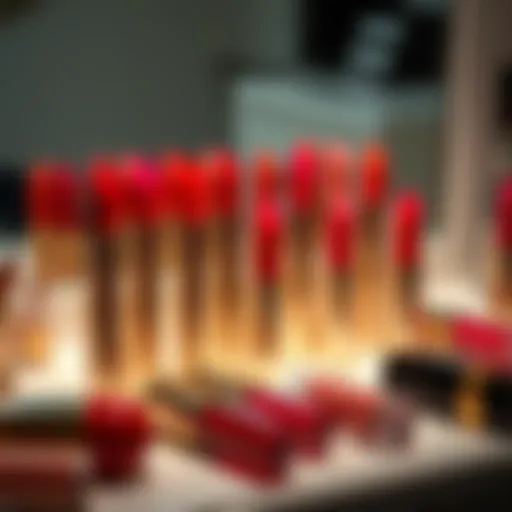Understanding Retinol 0.1%: Efficacy and Applications


Intro
Retinol at a concentration of 0.1 percent plays a significant role in modern skincare. Known for its ability to promote skin renewal, it is a derivative of vitamin A. This concentration has become popular among both new users and experienced skincare aficionados. 0.1 percent retinol is not only effective but also relatively gentle, making it suitable for a wider range of skin types.
In this article, we will explore the efficacy of 0.1 percent retinol, focusing on its applications and potential side effects. We will discuss how to incorporate it into your skincare routine effectively and which other ingredients it pairs well with. Moreover, we will take a look at consumer experiences and expert insights, ensuring a balanced view of the topic.
Understanding the nuances of retinol use can help improve your skincare results. It is crucial to know how it works and the considerations necessary for optimal outcomes.
Beauty Tips and Tricks
Skincare Routine Tips
Integrating 0.1 percent retinol into your skincare routine requires a little finesse. Begin by applying it once or twice a week to assess tolerance. Gradually increase frequency to every other night as your skin adjusts. Always remember to cleanse your face before application for better absorption.
- Apply at night. Retinol can increase skin sensitivity to sun exposure.
- Moisturize. Using a good moisturizer after retinol can help combat dryness.
- Sunscreen. Always use sunscreen during the day when using retinol products.
Haircare Hacks
While this article focuses primarily on skin applications, maintaining overall skin health, including areas like the scalp, can enhance benefits from retinol treatments. Ensure that your hair and scalp are also hydrated by using suitable hair oils. However, no direct haircare hacks are linked to retinol use.
Makeup Application Techniques
If you are using retinol, you might notice some flakiness or dryness in the skin initially. Here are some techniques to apply makeup more smoothly:
- Use a hydrating primer. This can create a better canvas for makeup application.
- Opt for liquid foundations. They tend to blend better on retinol-treated skin compared to powder formulations.
Product Reviews
In this section, we will discuss popular skincare product reviews that contain 0.1 percent retinol or similar effective ingredients. Consumer feedback and professional recommendations can guide your choices.
Skincare Product Reviews
One highly recommended product is Neutrogena Rapid Wrinkle Repair Retinol Oil. Users frequently point out noticeable improvements in skin texture and wrinkle appearance after consistent use. This product pairs well with other skincare ingredients to boost overall effectiveness.
Makeup Product Reviews
When considering makeup products, those with hydrating elements are ideal for use alongside retinol. Look for foundations with hyaluronic acid, as this can help maintain skin moisture levels.
Haircare Product Reviews
Some users suggest incorporating a good moisturizing conditioner to combat dry hair, particularly when experiencing any scalp sensitivity from retinol applications on the face.
Expert Beauty Advice
Professional Makeup Artist Insights
Makeup artists recommend using a gentle exfoliator to prep skin for makeup after retinol usage. This helps in buffing away any rough patches, ensuring foundation applies smoothly.
Skincare Specialist Recommendations
Experts advise a patch test when using retinol for the first time and caution against combining with other actives like AHAs or BHAs. That way, you can monitor reactions and reduce the risk of irritation.
Hair Stylist Tips
Hair professionals often emphasize a balanced approach to maintaining scalp health when using skin actives. Regular hydration and gentle cleansing can support skin and scalp wellness.
Beauty Industry News
Industry news can shape product transitions and trends in skincare. Awareness of new product launches or collaborations involving retinol and consumer preferences is key.
Product Launch Updates


Many popular brands now feature retinol in their anti-aging lines. Pay attention to those updates to stay informed on the latest formulations.
Beauty Event Coverage
Conventions often highlight newly released skincare innovations. Attending these events can deepen your understanding of how different products can work together, especially with retinol.
Celebrity Beauty Collaborations
Celebrity endorsements can often steer consumer interest towards particular retinol products. Examining these collaborations can provide insight into what is currently popular in skincare.
Preamble to Retinol
Retinol, a derivative of vitamin A, has emerged as a pivotal component in modern skincare regimens. This article will explore retinol at a 0.1 percent concentration, highlighting its significance in addressing various skin concerns. Retinol is not merely a trend; it is backed by scientific research demonstrating its ability to enhance skin texture, reduce signs of aging, and address acne issues. Understanding its historical context and chemical make-up helps one appreciate its efficacy and safety.
Historical Context
The journey of retinol in skincare began in the late 20th century, coinciding with advances in dermatology and biochemistry. Initially used in prescription formulations for severe skin conditions like acne, it gained popularity for its anti-aging benefits when researchers realized its effect on cell turnover and collagen synthesis. Over the years, retinol has been refined into over-the-counter products, making it more accessible without compromising its potent effects.
Chemical Composition
Retinol is a member of the retinoid family, known for its unstable structure that converts into retinoic acid when applied topically. This process is essential for its biological activity. At a concentration of 0.1 percent, it provides a balance between efficacy and tolerability. The presence of alcohol in its formulation often enhances stabilization, allowing the retinol to penetrate the skin effectively without causing excessive irritation. Its small molecular structure enables it to interact with skin cells, leading to improved skin texture and tone. Moreover, understanding its composition fosters informed decision-making regarding usage and expectations of results.
Retinol and Its Role in Skincare
Retinol is a crucial ingredient in modern skincare, renowned for its versatility and robust efficacy. This section delves into its multifaceted role in skincare, specifically focusing on its mechanisms and common applications. The significance of retinol lies in its ability to promote skin renewal and enhance overall skin health, making it a staple in many skincare routines.
Mechanism of Action
Retinol operates at a cellular level. When applied to the skin, it undergoes conversion to retinoic acid, the active form. This acid binds to receptors in skin cells, prompting various physiological responses. The primary actions include stimulating collagen production, accelerating cell turnover, and improving skin texture. As a result, users can experience a reduction in fine lines, smoother skin, and a more vibrant complexion. Understanding this mechanism is essential to appreciate retinol’s effectiveness and its positioning in skincare.
Common Uses
Retinol's versatility lends itself to various applications in skincare. The following subsections highlight specific uses, each addressing a common concern among users.
Acne Treatment
One of the most well-known applications of retinol is in acne treatment. Retinol removes dead skin cells and unclogs pores, reducing the formation of acne lesions. Its ability to regulate sebum production further helps prevent breakouts. This makes it a popular and effective treatment option for those battling acne, contributing significantly to clearer skin. However, users should note that initial use may lead to mild irritation, necessitating a gradual introduction into skincare routines.
Anti-Aging
In the realm of anti-aging, retinol’s reputation is formidable. It enhances collagen synthesis, which is crucial for maintaining skin elasticity. Over time, it can visibly reduce wrinkles and fine lines, making it a favored choice for those looking to combat signs of aging. Additionally, users often report an improved skin texture, resulting in a more youthful appearance. While retinol treatment may require consistent application to see long-term benefits, its effectiveness in fighting age-related skin concerns cannot be overstated.
Hyperpigmentation
Hyperpigmentation is another area where retinol shines. By promoting cell turnover, retinol helps fade dark spots and uneven skin tone. This characteristic makes it a valuable tool in the pursuit of a clearer and more uniform complexion. Users should be aware that while results can be promising, patience and consistent application are required, as noticeable improvement may take several weeks. Retinol proves to be beneficial, yet should be combined with sun protection to prevent potential exacerbation of pigmentation issues.
Understanding Concentration: The Case of 0. Percent
Understanding the concentration of retinol is crucial when considering its application in skincare. Different concentrations yield varying effects; therefore, knowing the benefits and limitations of a 0.1 percent formulation is necessary for informed use. This concentration often serves as a gateway for individuals looking to integrate retinol into their skincare routine without overwhelming their skin. It offers a balance between efficacy and gentleness, appealing to both novices and experienced users.
Why 0. Percent?
The choice of retinol at a concentration of 0.1 percent is backed by a specific rationale. For many users, this level represents a starting point. It provides significant advantages in addressing skin concerns such as aging and acne, while minimizing the risk of adverse reactions.
- Gentle Introduction: This concentration allows newcomers to see benefits while learning how their skin reacts.
- Efficacy: Numerous studies suggest that retinol at this level can still stimulate collagen production and cell turnover effectively, making it an attractive choice for various skin types.
- Lower Irritation Risk: A 0.1 percent concentration typically results in fewer side effects like redness or peeling, which can be common with higher concentrations.
Choosing 0.1 percent enables users to enjoy the positive aspects of retinol without heavily compromising their skin's integrity. It’s important for individuals to find a balance in their skincare to maximize results with minimal discomfort.
Comparative Analysis with Higher Concentrations
When considering retinol, higher concentrations like 0.5 percent or even 1 percent can be appealing due to their potency. However, these strengths can sometimes lead to increased irritation.


- Efficacy: Higher concentrations may accelerate results but can also escalate skin reactions.
- Skin Tolerance: A study of various concentrations illustrates that while higher doses may boast rapid results, they also have a greater tendency to provoke irritation and discomfort.
- Long-term Use: Sustained use of 0.1 percent retinol may provide more stable results over time, while higher concentrations may necessitate breaks to recover from irritation.
In summary, while higher concentrations of retinol can be effective, their potential for adverse effects makes them less accessible for casual users. The 0.1 percent formulation serves as a compromise that allows one to harness the benefits of retinol without risking excessive irritation. This makes it a smart choice, particularly for skincare newcomers.
Application Guidelines for Retinol 0. Percent
When using retinol at a concentration of 0.1 percent, understanding how to properly apply it is critical. This section outlines specific guidelines that enhance its efficacy while minimizing potential side effects. Following these guidelines allows users to achieve optimal results, reinforcing the retinol's beneficial properties in skincare.
Integration into Skincare Routine
Integrating retinol 0.1 percent into a skincare routine requires careful consideration. Begin by introducing retinol into your regimen gradually. For example, start with once a week, then slowly increase frequency as your skin adjusts. This method helps mitigate irritation often associated with retinol.
Combine retinol with other supportive products. Using a gentle cleanser, moisturizer, and sunscreen during the day enhances retinol's effectiveness. Also, avoid applying retinol during the day to reduce sun sensitivity. Instead, it is best used at night when skin repair processes are more active.
Frequency of Use
Determining the frequency of retinol use can significantly affect the results. For beginners, starting with one application per week is advisable. As skin builds tolerance, the frequency can increase to two to three times per week. Users with sensitive skin should proceed with caution and remain observant of their skin's reactions. Overusing retinol can lead to dryness or redness. Individuals with identified skin conditions may want to consult a dermatologist for personalized recommendations.
A common strategy for many is the "Sunday to Thursday" method. Here the user applies retinol on Sunday, Tuesday, and Thursday, allowing recovery time in between. This approach permits the skin to adapt without overwhelming it.
Proper Application Techniques
Applying retinol correctly maximizes its benefits. First, cleanse the skin thoroughly and pat it dry. Applying retinol on damp skin can increase irritation, so allow a few minutes after cleansing. Use a pea-sized amount of retinol and gently spread it over the face, focusing on areas in need of treatment. Avoid the eye area, as this skin is particularly sensitive.
- Tap the product gently into the skin rather than rubbing it in. This technique prevents excessive irritation.
- Be mindful not to layer multiple active ingredients simultaneously. For instance, using retinol and alpha hydroxy acids can intensify irritation.
- Finishing with a moisturizer is essential. This step helps lock in hydration and counteract any dryness or peeling that may occur with retinol use.
Consistency and patience are key. Results may take several weeks to appear, and sticking to the guidelines can make all the difference.
Implementing these application guidelines ensures an effective experience with retinol 0.1 percent, enabling users to maximize benefits while minimizing drawbacks.
Potential Side Effects and Considerations
Understanding the potential side effects and considerations regarding retinol 0.1 percent is crucial for anyone looking to incorporate it into their skincare routine. This section outlines common reactions, strategies to manage irritation, and the importance of professional guidance, ensuring a balanced approach to usage.
Common Adverse Reactions
Retinol is regarded for its efficacy. However, common adverse reactions can occur, particularly when starting treatment. Users may experience:
- Redness: Skin can show signs of redness, especially in sensitive areas.
- Peeling: A certain degree of skin flakiness is normal as the skin acclimates.
- Dryness: Some people may notice increased dryness, which may require additional moisturizer.
- Burning or Stinging: Mild stinging sensations may accompany application.
These reactions often signal that the skin is adjusting to retinol. Understanding this reaction profile can help users set realistic expectations when starting their journey with retinol.
"Skin sensitivity is common when using retinol, especially among new users."
Managing Irritation
Effectively managing irritation is vital to maintaining skin health while using retinol. Here are a few strategies:
- Start Slow: Begin with a lower frequency of application, such as every other night. Gradually increase to nightly as your skin builds tolerance.
- Buffering Method: Apply a moisturizer before the retinol. This can help minimize irritation by serving as a barrier.
- Hydration: Maintain a rigorous hydration routine, using moisturizers that contain hyaluronic acid or ceramides. These can aid in reducing dryness.
- Avoid Other Irritants: Steer clear of other potent ingredients, such as AHAs and BHAs, during the initial period of retinol use, as they can compound irritation.
Employing these techniques will help maintain skin integrity while allowing users to benefit from retinol’s powerful properties.
Consultation with Professionals
Consulting with skincare professionals is a prudent step when integrating retinol into your routine. Dermatologists can provide personalized recommendations based on individual skin types and concerns. Here are some key points:
- Tailored Recommendations: Professionals can offer advice on the best products for specific skin issues, ensuring optimal results.
- Monitoring Progress: Regular consultations allow for assessment of skin response, helping to adjust the regimen as needed.
- Addressing Severe Reactions: If significant adverse reactions occur, professionals can guide the user through alternative treatments or management strategies.
This professional support is invaluable, helping users navigate potential pitfalls and ensuring a successful experience with retinol 0.1 percent.
Compatibility with Other Ingredients


The concept of ingredient compatibility in skincare is crucial, especially when discussing retinol at a concentration of 0.1 percent. This section dives into how retinol interacts with other commonly used skincare components. Understanding these relationships can enhance the effectiveness of retinol while minimizing potential irritation or adverse reactions.
Combining with Acids
Retinol is often considered a powerhouse ingredient, and its efficacy can be influenced by the acids it is paired with. Lactic acid, glycolic acid, and salicylic acid are popular choices among skincare enthusiasts. However, caution is key when mixing retinol with these acids.
When using retinol concurrently with alpha hydroxy acids (AHAs) or beta hydroxy acids (BHAs), the potential for irritation increases due to their exfoliating properties. Thus, users should adopt a staggered application approach. For instance, using acids in the morning and retinol at night allows the skin to absorb and benefit from both without overwhelming it.
Remember: Always introduce new products gradually to assess tolerance levels.
Interaction with Moisturizers
Moisturizers play an essential role in a retinol regimen. They help counteract the dryness and irritation often associated with retinol use. However, not all moisturizers are created equal.
A moisturizer that contains occlusive ingredients can seal in moisture and prevent transepidermal water loss, which can be beneficial when using retinol. Yet, heavier formulations may hinder retinol absorption. Thus, lightweight, non-comedogenic moisturizers are often recommended.
Finding the right formulation can determine the balance between achieving results and managing side effects. A well-formulated moisturizer can enhance the experience and promote skin comfort while the user integrates retinol into their routine.
Targeted Treatments with Retinol 0. Percent
Targeting specific skin issues is a primary benefit of using retinol at a concentration of 0.1 percent. This strength is known for being effective while minimizing potential irritation. Many users find it a sweet spot for addressing multiple skin concerns. Thus, this section will discuss two critical areas where 0.1 percent retinol can shine: addressing fine lines and managing acne scars. Understanding these applications can help users achieve their desired skincare outcomes more effectively.
Addressing Fine Lines
Fine lines often signal the early signs of aging. Retinol 0.1 percent plays a significant role in combatting these visible effects. Its mechanism enhances cellular turnover, meaning it encourages the shedding of old skin cells. This process allows new, smoother skin to surface, which can help to diminish the appearance of fine lines.
Additionally, retinol increases collagen production, which is essential for maintaining skin elasticity. The result is not only less noticeable fine lines but also a more youthful skin texture overall. Users should note that while noticeable improvements can take a few weeks, commitment to consistent application may lead to satisfying long-term results.
Retinol works by promoting cell turnover and increasing collagen production to improve skin texture and reduce the appearance of fine lines.
Managing Acne Scars
Another vital application of retinol 0.1 percent is in managing the aftermath of acne. Acne scars can often be stubborn and challenging to treat. Retinol, however, can aid significantly in this regard due to its ability to enhance skin renewal. This leads to a gradual fading of hyperpigmented scars over time.
When applied regularly, retinol encourages the production of new skin cells. This process helps to break down scar tissue and promote smoother skin. Importantly, managing acne scars with retinol also requires a gentle approach. Individuals should monitor their skin's response to retinol, as the treatment may cause initial irritation or peeling. Combining retinol with soothing ingredients can be beneficial during this phase, optimizing the overall effect.
In summary, retinol 0.1 percent serves as a powerful ally in addressing fine lines and acne scars. It is important to understand the nuances of its application to maximize its benefits while minimizing side effects.
Real-world Experiences and Testimonials
The section dedicated to real-world experiences and testimonials serves a critical role in understanding the practical implications of using retinol at a concentration of 0.1 percent. It bridges the gap between clinical efficacy and personal experience, thus offering unique insights into how the product performs in everyday skincare routines. This section focuses on user experiences, providing a clearer context for the application of retinol and its impact on various skin concerns.
User Feedback
User feedback is essential for contextualizing the benefits and drawbacks of retinol 0.1 percent. Individual perspectives vary widely, depending on skin type, concerns, and previous experience with retinoids. People often report improvements in skin texture, clarity, and wrinkles after consistent use of retinol 0.1 percent.
Some users express satisfaction with faster results, while others highlight the initial adjustment period where irritation may occur. A notable theme in user feedback is the importance of patience and adherence to application guidelines. Many find that after the initial phase of potential peeling or sensitivity, their skin settles into a routine, yielding visible benefits. Compiling feedback from various sources, such as beauty forums and skincare blogs, it is evident that many enthusiasts share their routines and results, which can greatly aid others in their journey with retinol.
Case Studies
Case studies provide detailed narratives that reflect specific scenarios where retinol 0.1 percent was utilized. These studies often include baseline measurements and follow-up assessments to gauge effectiveness objectively.
One exemplary case involved a 30-year-old woman with combination skin presenting with early signs of aging. After a two-month regimen of retinol 0.1 percent, changes were noted in her fine lines and overall skin brightness. Dermatological assessment revealed an improvement in skin texture by 30% compared to standard moisturizers alone.
Another case study investigated a male subject in his late 20s dealing with acne scars. He incorporated retinol 0.1 percent into his routine alongside vitamin C. After three months, both subjective feedback and visual assessments indicated significant lightening of scars and a reduction in breakouts.
These case studies highlight the tailored approach necessary for implementing retinol 0.1 percent, showcasing variations in treatment outcomes based on individual skin profiles and complementary products.
Real-world testimonials and detailed case studies are crucial for understanding the efficacy of retinol 0.1 percent in diverse settings, serving as a guide for both new users and experienced individuals looking to refine their skincare regimens.
Closure
In the realm of skincare, understanding the nuances of active ingredients can significantly enhance the overall effectiveness of a regimen. This article has highlighted the specificities of retinol at a 0.1 percent concentration, outlining its diverse applications and efficacy in addressing various skin concerns. It serves not only as an informational resource but also as a guide, providing insights for both novices and seasoned skincare enthusiasts. The importance of integrating retinol into one’s skincare routine cannot be overstated.
Balanced application can yield impressive results, while also considering potential side effects. A comprehensive understanding of the product fosters better user experiences and encourages informed decision-making regarding skincare choices. This is particularly relevant given skincare is not a one-size-fits-all domain, and individual skin types require tailored approaches.
Summarizing Key Points
- Efficacy of Retinol: At a concentration of 0.1 percent, retinol has demonstrated considerable effectiveness in improving the skin's texture and tone, reducing fine lines and hyperpigmentation.
- Application Guidelines: Understanding how to properly integrate retinol into a skincare routine is essential for maximizing its benefits while minimizing irritation.
- Compatibility: It is crucial to assess how retinol interacts with other ingredients to enhance or inhibit its effects. Knowledge on combining with other acids or moisturizers is vital to avoid adverse reactions.
- Real-world Experiences: User testimonials and case studies provide valuable insights on the practical applications and outcomes of using retinol, helping future users set realistic expectations.







